Something went wrong!
Hang in there while we get back on track
Best attractions in Ascoli Piceno

The Piazza del Popolo is one of the most harmonious Renaissance squares in Italy and has been considered the "living room" of Ascoli Piceno since the 16th century. Covering an area of 2500 m², this rectangular square is entirely paved with polished travertine and is framed by the impressive Palazzo dei Capitani with its medieval tower and the Gothic Church of San Francesco.
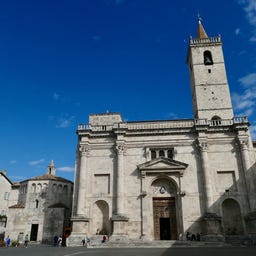
The majestic Cattedrale di Sant'Emidio combines impressive Romanesque and Renaissance elements in its architecture, which have developed over centuries into a harmonious work of art. Built from polished travertine, the cathedral has origins dating back to the 5th century and received its current façade between 1529 and 1539 by the architect Cola dell'Amatrice. In the 11th-century crypt, you can find the tomb of Saint Emidius in a repurposed pagan sarcophagus from the 3rd century, while in the Chapel of the Holy Sacrament, you can admire the famous polyptych by Carlo Crivelli from 1473.

In the heart of Ascoli Piceno, the elegant Caffè Meletti has been standing proudly at Piazza del Popolo since 1907 - a historic café in the Liberty style with its distinctive light pink facade. Behind the neoclassical front with its colonnade, you’ll find a stylishly furnished interior featuring original wooden furniture, velvet sofas, and a beautifully painted ceiling dedicated to the house's own anise liqueur by the artist Pio Nardini.
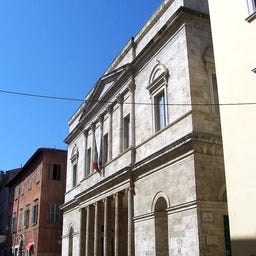
In the heart of Ascoli Piceno, you will find the Teatro Ventidio Basso, the city's most important theater, which was inaugurated in 1846 after six years of construction with works by Giuseppe Verdi and Vincenzo Bellini. The neoclassical building impresses with its grand facade featuring six Ionic columns and offers seating for 842 visitors in its horseshoe-shaped auditorium with four tiers.
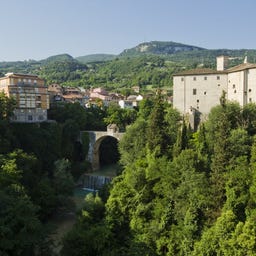
On the remains of Roman baths stands the Forte Malatesta, an impressive fortress designed by Antonio da Sangallo the Younger in 1540 on behalf of Pope Paul III. The star-shaped structure, with its three levels of gun emplacements, served as a prison until the 1980s and was reopened as a museum complex in 2010 after ten years of restoration.
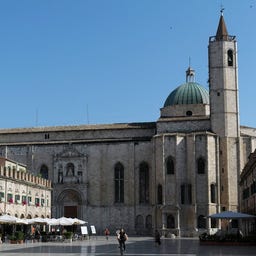
The impressive Chiesa di San Francesco in the heart of Ascoli Piceno is one of the most significant examples of Franciscan architecture in Italy and commemorates the visit of Saint Francis in 1215. The construction of the church, which took place from 1258 to 1549, combines Romanesque and Gothic elements and captivates with its distinctive travertine facade featuring three Gothic portals.
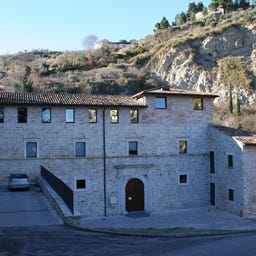
In the impressive Cartiera papale, a facility built from massive travertine blocks, you will experience a fascinating piece of industrial history from the early 12th to the 17th century.
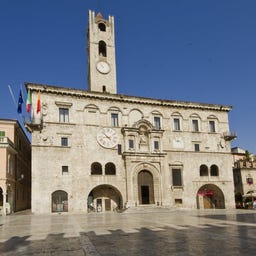
In the heart of Ascoli Piceno stands the Palazzo dei Capitani del Popolo, with its medieval tower overlooking the elegant Piazza del Popolo. Built in the 13th and 14th centuries, the palace was extensively restored after a fire during a noble uprising in 1535 and served as the seat of the papal governors until 1860.
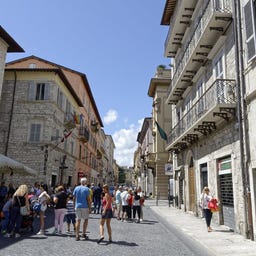
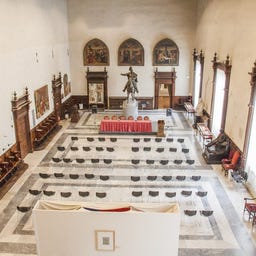
In the magnificent Palazzo dell'Arengo at Piazza Arringo, you will find one of the most significant art collections in Central Italy. The Pinacoteca civica, opened in 1861 by Giorgio Paci and Giulio Gabrielli, showcases impressive artworks from the 14th to the 20th century across 15 exhibition rooms, including pieces by Titian and Carlo Crivelli.
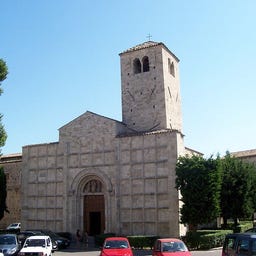
In the medieval old town of Ascoli Piceno stands the Chiesa dei Santi Vincenzo e Anastasio, one of the oldest and most artistically significant churches in the city, whose construction began in the 9th century and was completed in 1389. The distinctive façade, with its 64 square panels that once featured religious frescoes, is reminiscent of the Cathedral San Rufino in Assisi, making the church an architectural gem of the region.
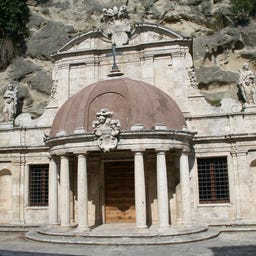
In the natural caves outside Ascoli Piceno, you will find the Tempietto di Sant'Emidio, a fascinating example of Baroque sacred architecture from the early 18th century. Designed by Giuseppe Giosafatti, the temple was built between 1717 and 1720 as a thank you for protection from earthquakes and marks the spot where Saint Emidius is said to have suffered his martyrdom in 303.
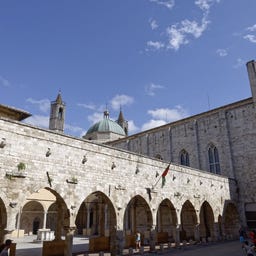
In the heart of the city, you will find the Chiostro Maggiore di San Francesco, an impressive cloister from the 14th century featuring Gothic arches and a distinctive fountain. The courtyard, also known as the "Piazza della Verdura," is surrounded by 20 arcades on Corinthian columns and hosts a vibrant herb market on weekdays.
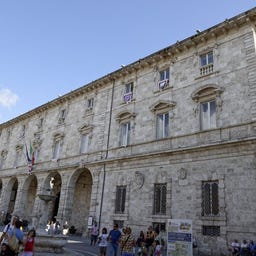
The impressive Palazzo dell'Arengo dominates the southern side of the Piazza Arringo in Ascoli Piceno, blending medieval and baroque architectural elements. The original core of the building was established in the late 12th century with the founding of the Free Commune, before it took on its magnificent form in the 17th century under the guidance of Giuseppe Giosafatti.

The impressive Porta Gemina is one of the oldest and most significant city gates in Ascoli Piceno, Italy. It was built in the 1st century BC as a typical Roman structure made of massive travertine blocks. With its two arches, each standing 5.70 meters high and resting on three powerful pillars, it was integrated into the city's fortification system during the Middle Ages and survived dramatic destruction by Frederick II.
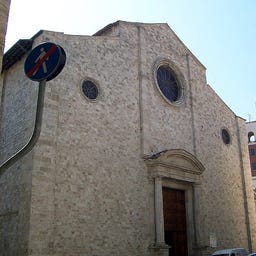
The Chiesa di San Pietro Martire is one of the most significant Gothic churches in the Marche region and has shaped the historic center of Ascoli Piceno since the 13th century. Built by Dominicans between 1280 and 1332, the church impresses with its grand width and three naves, dedicated to Saint Pietro da Verona, who visited the city in 1250. Inside, you will find valuable 14th-century frescoes, including a "Crucifixion" and "Noli me tangere," as well as magnificent Baroque altars from the late 17th century. A special treasure is the monumental reliquary in the right apse, which, according to tradition, contains a thorn from Christ's crown of thorns and is celebrated annually during the Festa della Sacra Spina.
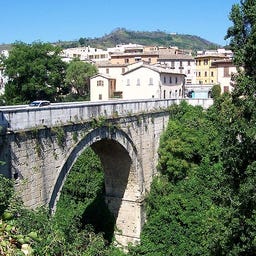
The Ponte Romano di Solestà in Ascoli Piceno is one of the most impressive examples of Roman engineering from the time of Augustus. The 62-meter-long travertine arch rises 25 meters above the Tronto River and still connects the city center with the Porta Cappuccina district.
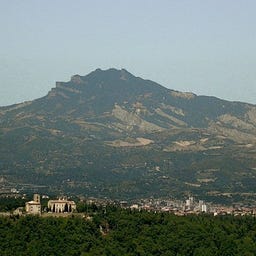
The 1,110-meter-high Monte Ascensione rises prominently in the Italian province of Ascoli Piceno and offers you a breathtaking panoramic view from the Sibillini Mountains to the Adriatic coast.
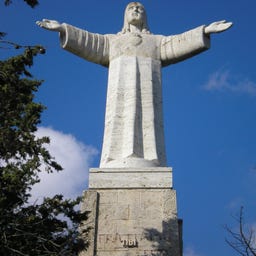
High above Ascoli Piceno stands the 12-meter tall statue of Christ made of travertine, erected in 1954 as a thank you for protection during World War II. The Cristo Redentore, created by Antonio Mancini and placed on a 7-meter pedestal by Vincenzo Pilotti, was crafted from local stone from Castel Trosino.
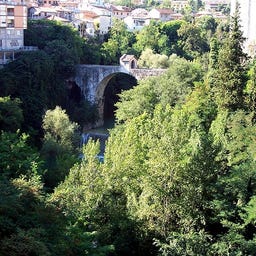
The oldest bridge in Ascoli Piceno connects the Porta Maggiore district with the Forte Malatesta, spanning the Castellano River with two elegant arches made of light travertine. Its Roman origins, long believed to be medieval, were only confirmed by the architect Giambattista Carducci. After its destruction in World War II, the bridge was faithfully rebuilt in the 1960s using the recovered original stones.
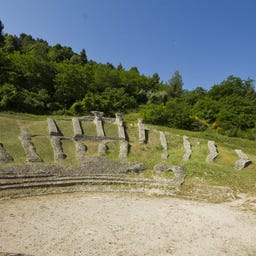
In the western part of the old town of Ascoli Piceno, you will find an impressive example of Roman theater architecture from the 1st century BC. The Teatro Romano, rediscovered in 1932, was extensively restored and reopened in 2010, captivating visitors with its impressive size, measuring 95 meters in diameter.
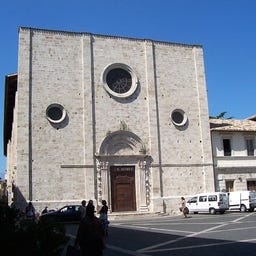
The Chiesa di Sant'Agostino in the historic center of Ascoli Piceno fascinatingly combines Romanesque, Gothic, and Renaissance elements. Originally built in the early 13th century as a modest place of worship, the church underwent several significant renovations between the 14th and 16th centuries, shaping its current appearance with the distinctive three-part façade and the intricately decorated portal from 1547.

The Porta Tufilla is one of the best-preserved city gates in Ascoli Piceno and was built between 1552 and 1555 under the direction of the architect Camillo Merli. The impressive archway, named after a small tuff stone projection at its base, is topped by a picturesque loggia with three openings.
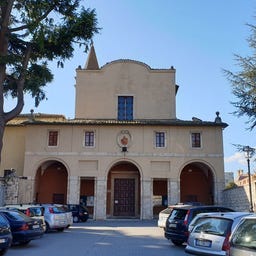
In the Chiesa di San Serafino da Montegranaro, over 1200 years of history come together—from its founding in the 8th century as Santa Maria "in Solestano" to the current neoclassical structure built in 1779. Under the care of the Capuchins since 1569, the church houses the tomb of Saint Serafino beneath its main altar, where he lived from 1590 until his death in 1604.
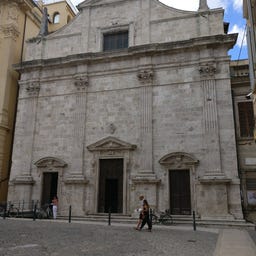
The Chiesa di Santa Maria della Carità, commonly known as the "Chiesa della Scopa," is an impressive Baroque church in the heart of Ascoli Piceno. Built in the 14th century and extensively remodeled starting in 1532, the sacred building was designed by architects Cola dell'Amatrice and Conte Conti and completed in 1583.
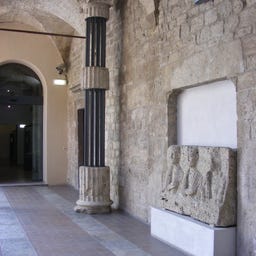
In the historic Palazzo Panichi from the 16th century, you will discover a fascinating journey through the history of the Marche region. The museum, founded in 1981, showcases both the culture of the Piceni and significant Roman artifacts in two main sections, including a remarkable portrait of Emperor Trajan.
Just 2 kilometers south of Ascoli Piceno, a historic path leads you to a remarkable bridge from the time of Augustus: the Ponte del Gran Caso. Built from travertine, this Roman bridge spans the Gran-Caso stream with a length of 6 meters and was once part of the significant Via Salaria.
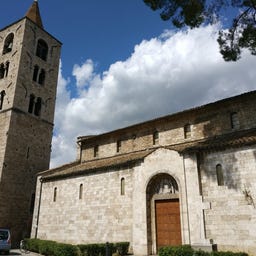
The Chiesa di Santa Maria Intervineas is one of the rare church fortresses in Italy, with a history dating back to the 5th century when a miraculous Madonna image was found among the vineyards.
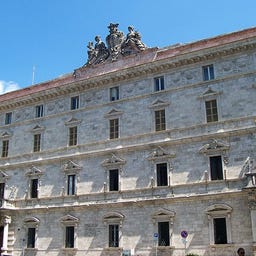
The impressive Palazzo del Governo dominates the entire eastern side of the Piazza Fausto Simonetti and is one of the largest buildings in Ascoli Piceno. Originally designed as a monastery, the construction took place between the early 18th century and 1797, with various architects, including Giuseppe Giosafatti, contributing to its design.
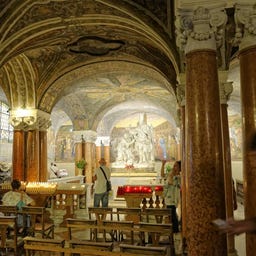
Beneath the presbytery of the Cathedral of Sant'Emidio in Ascoli Piceno, you will find a mystical crypt from the 11th century, which has housed the relics of the city's patron since 1054. In this square space, there are 63 columns made of travertine and red Veronese marble, separating ten small side aisles and three central passages.
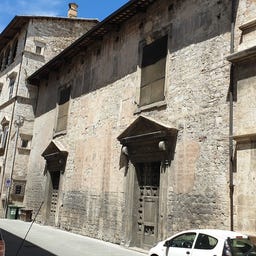
In the historic center of Ascoli Piceno stands the Palazzo Malaspina, a significant example of Renaissance architecture built by Cola dell'Amatrice between 1532 and 1583. The impressive palace, still inhabited by the Malaspina family, captivates with its distinctive façade featuring twin portals and rows of three windows stacked on top of each other, with the ornate windows on the noble floor particularly striking. Inside, you can admire magnificent frescoes depicting mythological scenes by Biagio Miniera from the early 18th century, as well as a remarkable garden with a richly decorated fountain from the 16th century. On the left side of the palace, you can still find the remnants of a medieval noble tower that was partially destroyed in the 18th century.
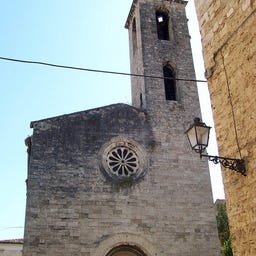
In the heart of the historic center of Ascoli Piceno, you will find the Chiesa di San Giacomo Apostolo, a remarkable example of Romanesque architecture with Gothic influences from after 1250. The church, built entirely from local travertine, captivates with its distinctive façade featuring a rose window made of twelve columns and five cross-shaped majolica plates.
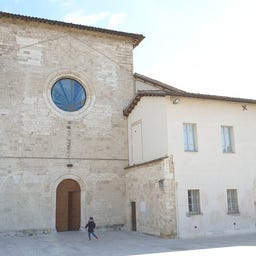
The simple Chiesa dei Santi Pietro e Paolo in the Campo Parignano district is one of the oldest churches in Ascoli Piceno. Founded by the devout Amata in 1206, the church impresses with its clear Romanesque architecture made of regular travertine blocks and today showcases its medieval simplicity again, after Bishop Morgante had it restored in the 20th century.
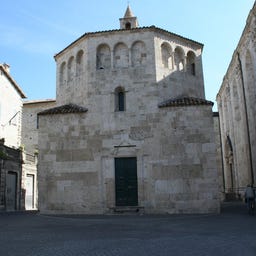
The Battistero di San Giovanni, built in the 5th/6th century, is one of the most significant Romanesque structures in Ascoli Piceno and is protected as a national monument. The octagonal baptistery with its distinctive dome rises on the Piazza Arringo, right next to the Cathedral of Sant'Emidio, likely on the foundations of a Roman temple dedicated to Hercules.
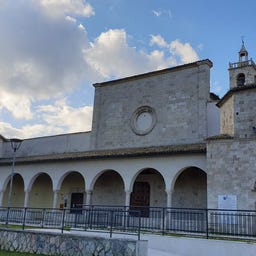
High above Ascoli Piceno stands the Chiesa della Santissima Annunziata in the park of the same name, offering you an impressive panoramic view of the city. What began as a hospital in the 13th century and was later used by Augustinians and Franciscans now houses the architecture and design faculty of the university.
In the historic center of Ascoli Piceno, you'll find the Teatro dei Filarmonici, a charming neoclassical theater from the early 19th century. The horseshoe-shaped auditorium, with its two tiers and gallery, accommodates 400 visitors and captivates with the intricate stuccos by sculptor Giorgio Paci, featuring Medusa heads and floral motifs. After a tumultuous history—transitioning from a city theater to a cinema and then facing temporary closure—the venue has been shining anew since its extensive restoration in 2018 and now serves as a vibrant cultural hub.
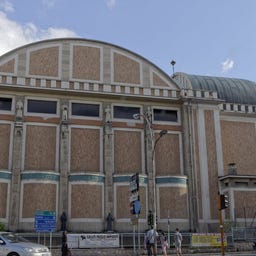
The "Church of the Immaculate Heart of Mary" is located in the LucianiS. Bracci neighborhood, The Convent and the Parish of the Immaculate Heart of Mary in Ascoli Piceno, "op. cit.", p. 20, in the area known as Caldaie, in Ascoli Piceno.
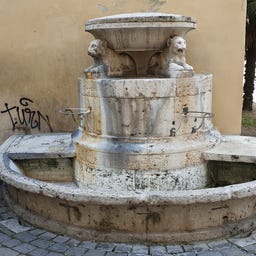
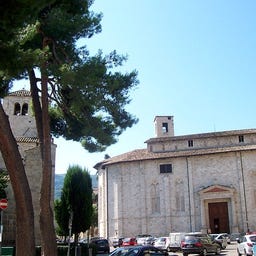
On the Piazza Ventidio Basso in the historic center of Ascoli Piceno, you experience a fascinating mix of Romanesque churches, medieval houses, and Renaissance buildings. The square, which was the commercial heart of the city until the 17th century, was once used as a marketplace for wool and textiles—evidenced today by the "Gabella della Staterola" stone from 1613, which details trade regulations.
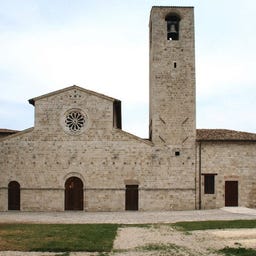
The Chiesa di San Tommaso Apostolo is one of the most significant Romanesque churches in the historic center of Ascoli Piceno, with origins dating back to 1064. The striking travertine facade, featuring a three-part structure and a magnificent rose window, took on its current form in the 13th century. Inside, you will find a three-nave basilica adorned with intricate stuccos by Emidio Paci from the 19th century, as well as a valuable main altar with a tabernacle from the 16th century. Particularly noteworthy are the four holy water basins made from Roman capitals and the bell tower, which houses the oldest bell in Ascoli, dating back to 1283.
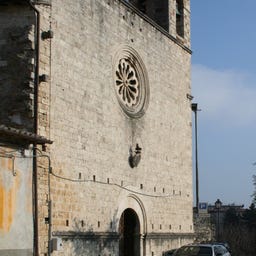
High above the Roman Bridge, the Romanesque Chiesa di San Pietro in Castello sits on a small rock - a fascinating testament to medieval urban history. Originally founded in the 8th century by the Lombard bishop Oderisio, the church was rebuilt in 1142 and took on its current form through extensive renovations by builders from Como between 1466 and 1468.
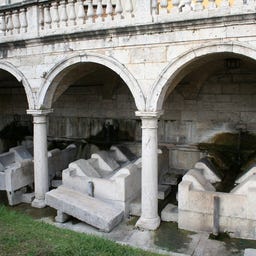
In the historic district of Porta Cappuccina in Ascoli Piceno, you will discover the Lavatoio pubblico, a public washhouse from the 17th century, also known as the Fonte di Sant'Emidio. The entire complex, built from travertine, impresses with its elegant loggia featuring five airy arches and even includes architectural elements from the 12th century. A local legend tells that the city's patron, Sant'Emidio, once struck a rock here to obtain baptismal water. Strict historical regulations from 1625 governed the use of the washhouse, particularly protecting the rights of the women who washed there.
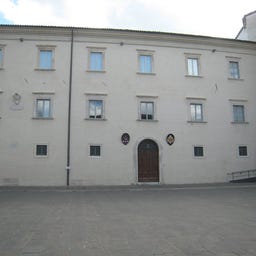
In the right wing of the magnificent Palazzo dell'Episcopio at Piazza Arringo, you will find the diocesan museum founded in 1961 by Bishop Marcello Morgante. The impressive collection of sacred art includes paintings, sculptures, and precious silver works from the 13th to the 20th century, most of which come from Ascoli and the surrounding region.
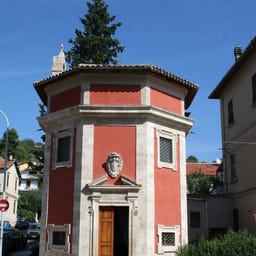
Right outside the city walls of Ascoli Piceno, you’ll find the completely red-painted Tempietto di Sant'Emidio Rosso, an octagonal sacred building made of smooth travertine. According to legend, this is the spot where the city’s patron Sant'Emidio was beheaded - the stone from his execution is still kept under the simple altar. The small temple, which originated from a votive chapel in the 16th century and was expanded in 1633, features a painting of the beheading scene above the altar in the local style of the 18th century. Today, you’ll discover a vibrant place of worship that attracts both locals and visitors.
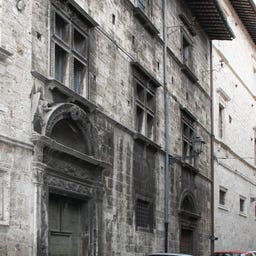
The "Palazzo Bonaparte" is a building in Ascoli Piceno that stands out for the uniqueness of the decorations and bas-reliefs sculpted on its facade, which enhance its elegant beauty.
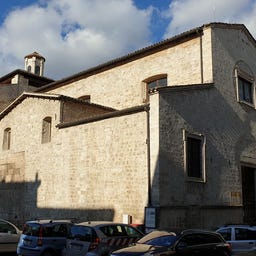
The "Church of San Venanzio" is a place of worship located in the historic center of Ascoli Piceno, just a stone's throw from Piazza del Popolo.
The "Grotte dell'Annunziata" are one of the monumental constructions of Roman Asculum. They are actually artificial caves, technically referred to as "substructions." These are niches with barrel vaults, built against three sides of the rock face of the Colle dell'Annunziata, completely surrounding the eastern side. A unique feature of the structure, perhaps one of a kind, is the wedge-shaped termination of the arches, likely designed to better anchor the structure to the rocky hill.
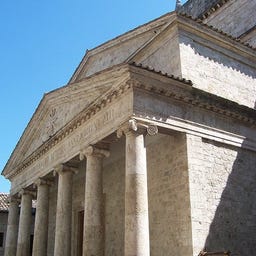
The "Emidio Neroni Auditorium" in Ascoli Piceno is located on Rua del Cassero, in the historic center of the Marche city.
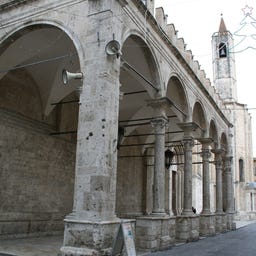
At the Piazza del Popolo in Ascoli Piceno, the elegant Loggia dei Mercanti rises, a Renaissance arcade made of travertine supported by five Corinthian columns. Completed in 1514 by Francesco Rubei di Villagona, the loggia was originally built as an exhibition space for goods from the local wool guild.
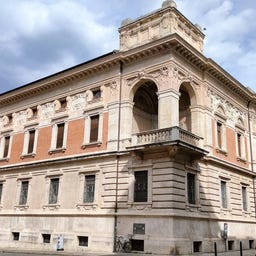
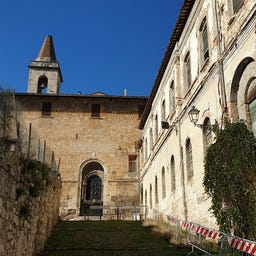
The "Church of Sant'Angelo Magno" is located in the historic center of the city of Ascoli Piceno, in the ancient district of Piazzarola.
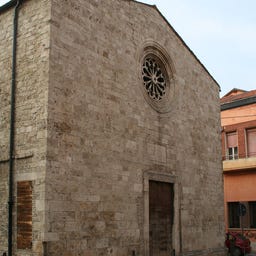
The "Church of San Giuliano" is located in the historic center of the city of Ascoli Piceno, in the Marche region.
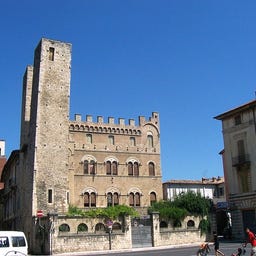
The "Merli Palace" is a building in the historic center of Ascoli Piceno, located in Piazza Sant'Agostino in front of the church of the same name.
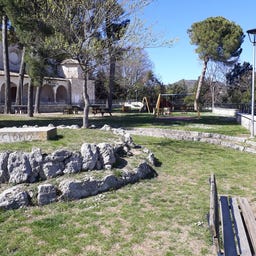
The "Annunziata Park" is a public park in Ascoli Piceno. Located in the highest area of the city, on the ancient Pelasgic hill, it is considered the green lung of Ascoli.
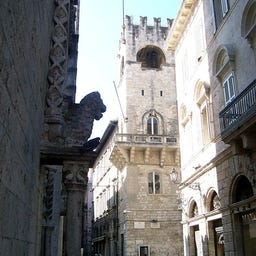
The "Tower of Alvitreti" is located in the historic center of Ascoli Piceno, near the Renaissance Piazza del Popolo.
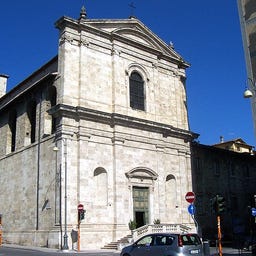
The "Church of Santa Maria del Carmine" is a Catholic place of worship, located in the historic center of Ascoli Piceno, at the end of Corso Mazzini, the ancient main decumanus of the Roman city, in close proximity to Piazza Giacomo Matteotti, the Ponte Maggiore, and the Forte Malatesta.
"Piazza San Tommaso" is located in the north-west area of the historic center of Ascoli Piceno, in the San Giacomo district. It is named after the Church of San Tommaso Apostolo. It is colloquially known in the Ascoli dialect as "Lu Spiazzë dë Ventura."
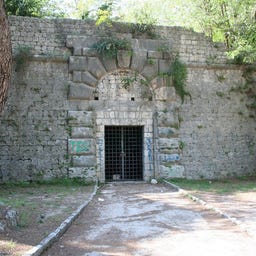
High above Ascoli Piceno, on the Colle dell'Annunziata, stands the partially overgrown Fortezza Pia, a fortress ruin with a rich history. Originally dating back to the Piceno-Sabine period, the structure was reinforced with bastions in the 16th century by Pope Pius IV and was part of the city's defense system.
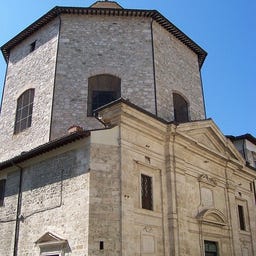
The "Church of the Immaculate Conception" is a Catholic place of worship, located in the historic center of Ascoli Piceno in the San Giacomo district.
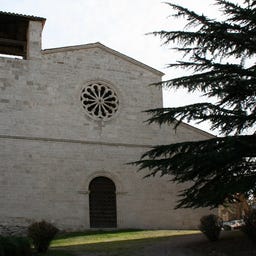
The Romanesque Chiesa di San Vittore in the center of Ascoli Piceno is one of the oldest churches in the city, first mentioned in documents in 966. The completely travertine-built structure impresses with its simple aesthetics, featuring three naves, a low bell tower, and an intricately restored rose window.
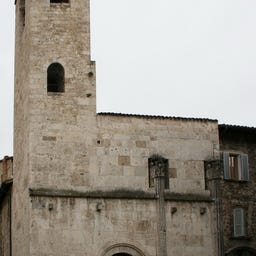
In the Church of San Gregorio Magno, you will find a fascinating example of the transformation of a Roman temple into a Christian church. Originally built in the 1st century BC, likely dedicated to the goddess Isis, the structure received its Romanesque facade in the 13th century and was consecrated to Pope Gregory I.
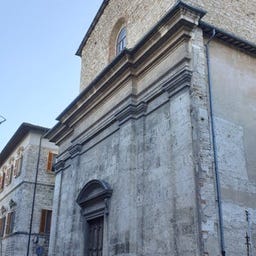
The "Church of Santa Maria del Buon Consiglio" is a Catholic place of worship located in the historic center of Ascoli Piceno, on Corso Mazzini in the San Giacomo district.
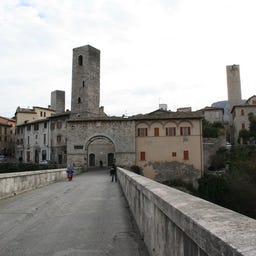
The impressive Porta Solestà is one of the best-preserved medieval city gates in Ascoli Piceno and was built in 1230 under the guidance of Fildesmilio da Mogliano. The grand archway made of travertine blocks was constructed from the remains of a Roman predecessor and still bears Latin inscriptions from the 13th and 15th centuries, documenting significant historical events.
In the Church of Sant'Agostino in Ascoli Piceno, you will find a remarkable collection of contemporary art dedicated to the Italian painter Osvaldo Licini. Established in 1964 as a municipal gallery for modern graphics, the exhibition now houses around eighty works by Licini, as well as paintings by notable artists like Lucio Fontana, Giorgio Morandi, and Gino Severini.
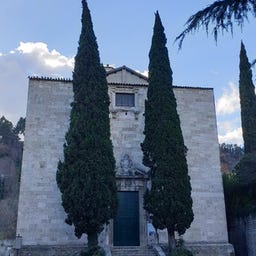
The "Church of the Most Holy Crucifix of the Icon," also known as the "Church of Santa Maria delle Grazie," is a Catholic place of worship located in Piazza Cecco d'Ascoli in the western part of the historic center of Ascoli Piceno, between the Roman Theatre and the medieval walls with Porta Romana.
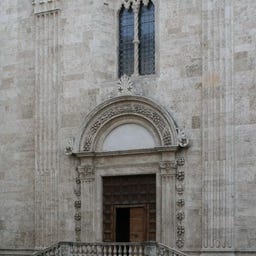
On the left side of the Duomo di Sant'Emidio, the side entrance of the cathedral of Ascoli Piceno opens, known as "La Porta della Musa." A poetic name that derives from the inscription of the distich, in Latin, that can be read on the block of travertine embedded near the door:
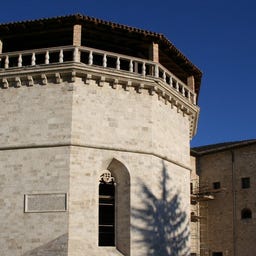
The "Church of Santa Maria del Lago" in Ascoli Piceno stands integrated within the structure of the Malatesta fortress complex, near Ponte Maggiore.
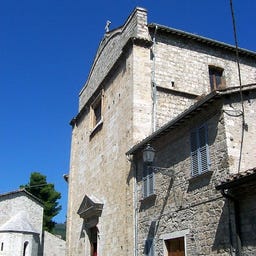
The "Church of Sant’Onofrio" is a Catholic place of worship, located in the historic center of Ascoli Piceno, near the monumental Piazza Ventidio Basso.

The "Church of Sant'Ilario" in Ascoli Piceno, currently deconsecrated, is located in front of the small temple of Sant'Emidio alle Grotte, in the Campo Parignano district.
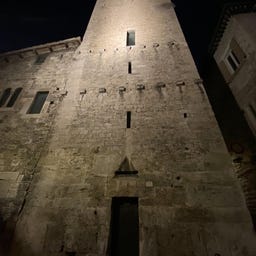
The "Longobard Palace" of Ascoli Piceno is a small medieval building of Romanesque art, used as a residence, which has no connections to the Lombard people. Its architectural composition constitutes a "palatium-turris," the only perfectly preserved example in the city from the early communal period, which includes the palace and the adjacent tower of the Ercolani family.
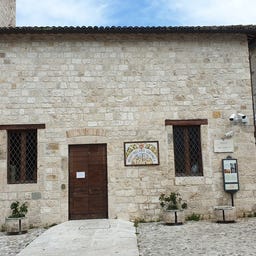
The "Museum of Ceramic Art" is located in Ascoli Piceno, in the picturesque cloister of the former convent of the Romanesque church of San Tommaso, which overlooks the square of the same name. It was inaugurated on June 1, 2007.
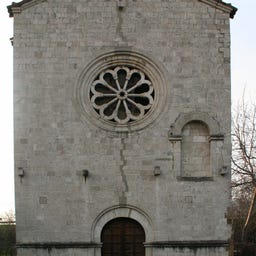
The "Church of Santa Maria delle Donne" in Ascoli Piceno was built in the early 13th century on the plain of San Panfilo, outside the city walls, just beyond Porta Romana, in the neighborhood of the same name.
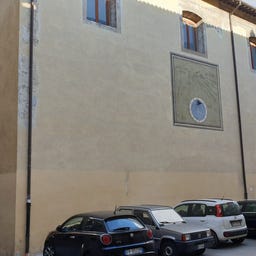
In the historic old town of Ascoli Piceno, you will find the Chiesa di San Cristoforo, a baroque church from the late 16th century, also known as the "Church of the Brotherhood of Good Death." Built between 1593 and 1598, it features three magnificent baroque altars made of Ascoli plaster, created by Giuseppe Giosafatti, as well as significant paintings by the artist Lodovico Trasi.
The "Minor Cloister of San Francesco," along with the Major Cloister, is part of the complex of the Church of San Francesco in Ascoli Piceno, in the Marche region.
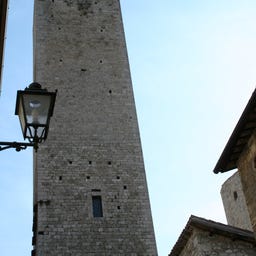
Rising impressively to a height of 34.5 meters, the Torre degli Ercolani stands as a remarkable example of a medieval residential tower from the 12th/13th century in the sky of Ascoli Piceno. Built from solid travertine blocks, the tower combines noble architecture with clever defensive techniques—ranging from wooden throwing balconies to sophisticated mechanisms for boiling oil.
The "Church of San Biagio" was a church located in Ascoli Piceno in the central Piazza Arringo, in front of the entrance to the Baptistery of San Giovanni. It was demolished in 1887.
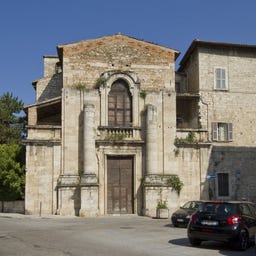
The "Church of the Guardian Angel" is a place of Catholic worship, located in Piazza Cecco d'Ascoli in the western part of the historic center of Ascoli Piceno, near the Church of the Most Holy Crucifix of the Icon and the medieval walls with Porta Romana.
